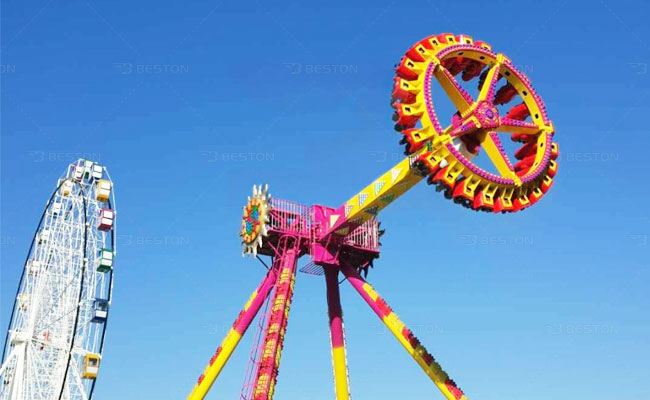Understanding what makes an amusement ride exciting isn’t just about colors, height, or speed—it’s often the physics working quietly behind the scenes. One of the most intriguing examples is the pendulum ride. This attraction captures riders’ attention through dynamic motion, predictable rhythm, and natural gravitational forces. By exploring the scientific foundation behind pendulum rides (маятник аттракцион), amusement park owners and engineers can better appreciate how thrill and safety are harmonized.
How Motion Shapes the Experience
A pendulum ride mimics the movement of a swinging object pivoting from a fixed point. This simple concept is governed by the laws of classical mechanics, particularly Newtonian motion. When the gondola is released from a resting position, it accelerates due to gravity. As it moves downward, potential energy is converted into kinetic energy, propelling the structure forward.
This back-and-forth swinging builds momentum until friction and air resistance eventually reduce the energy unless it is maintained by a motor. For amusement rides (экстремальный аттракцион), propulsion systems keep the swing going, often pushing it higher with each pass.
The Role of Inertia and Gravity in Design
Inertia plays a key role in the pendulum ride’s behavior. When the ride begins, the mass of the gondola resists motion. However, once it moves, it tends to stay in motion unless acted upon by an external force. This explains the consistent, rhythmic swinging pattern that is both exhilarating and soothing for park guests.
At the same time, gravity ensures that the motion feels organic. Every ascent is followed by a natural drop, creating a predictable yet thrilling cycle. The balance between these two forces is essential not only for the excitement but also for operational safety and smooth ride dynamics.
Comparing Pendulum Rides to Vertical Attractions
While pendulum rides rely on arcs and swinging, other thrill rides focus on vertical movement. A prime example is the drop tower ride (аттракцион башня свободного падения)—a towering attraction where passengers are lifted high into the air before being released into a sudden free-fall. Unlike the pendulum’s predictable rhythm, drop towers exploit gravity in a much more intense, abrupt fashion.
From a physics standpoint, drop towers capitalize on gravitational acceleration (9.8 m/s²). Riders fall almost unhindered, with their bodies temporarily in a state of free fall. This creates a sharp contrast to pendulum rides, which offer more gradual transitions between motion states. Including both ride types in a park offers guests a diverse selection of gravity-based experiences.
The Psychological Effect of Swinging Motion
There’s a psychological angle to the pendulum ride that makes it universally appealing. Humans are naturally conditioned to respond to rhythmic motion—think of cradles, rocking chairs, or swings. The pendulum ride taps into this familiarity, amplifying it with height and speed to cross into thrill territory.
That feeling of the stomach “dropping” occurs when riders are momentarily in free fall, especially during the return swing. Even though the movement is mathematically predictable, the body’s internal sensors interpret it as sudden, causing an adrenaline rush. This blend of emotional and physical stimulation is what makes pendulum rides so effective in drawing crowds.
Integrating Engineering Precision into Thrill Design
Behind every safe pendulum ride is meticulous engineering. Designers use simulation software and mathematical modeling to determine the optimal arc length, swing radius, and load capacity. Calculations ensure that centrifugal force during the peak swing doesn’t exceed safe thresholds and that structural stress is evenly distributed.
Additionally, counterweights, shock absorbers, and advanced braking systems are used to manage motion safely. Whether it’s an open gondola or an enclosed capsule, the design must align with both physical laws and human anatomy. The integration of physics into real-world design is what separates high-quality attractions from average ones.
A Scientific Comparison with Roller Coasters
Many park owners debate whether to install a roller coaster (американские горки купить) or a pendulum ride as their centerpiece attraction. While coasters often feature complicated layouts with drops, turns, and inversions, their physics are still rooted in gravitational forces, kinetic energy, and centripetal motion.
In contrast, the pendulum ride focuses on a more simplified movement pattern but delivers equally intense feelings of weightlessness and motion. Roller coasters provide variety through track design, but pendulum rides can achieve a similar emotional effect using repetitive arcs. From a physics standpoint, both use energy conservation principles, but in uniquely thrilling ways.
Designing for Maximum Impact and Minimal Risk
Every aspect of the pendulum ride—from launch angles to maximum swing height—is based on physics. Ride manufacturers must account for g-forces to ensure they remain within human tolerance. Excessive g-force can lead to discomfort or health risks, which is why engineers use models to simulate performance before the first bolt is fastened.
The placement of the pivot point, the length of the arm, and the swing radius all impact how the ride feels. Modern pendulum rides can even include rotational seating platforms, which introduce angular momentum into the equation, resulting in more dynamic, multi-dimensional experiences.
Why Physics-Based Rides Remain Timeless
The reliance on gravity and motion rather than gimmicks gives pendulum rides a timeless quality. They’re easy to understand, deeply rooted in physical principles, and emotionally resonant. As amusement technology evolves, many attractions grow more complex—but pendulum rides continue to stand tall, both literally and figuratively, because of their elegant simplicity.
Conclusion
Understanding the science behind the pendulum ride adds a new layer of appreciation for its design. By relying on principles like gravity, inertia, and momentum, these rides deliver high-thrill, low-risk experiences that rival even the most elaborate roller coaster or dramatic drop tower ride. For park operators aiming to blend excitement with safety and reliability, a pendulum ride built on strong physics may be one of the smartest investments they can make.

